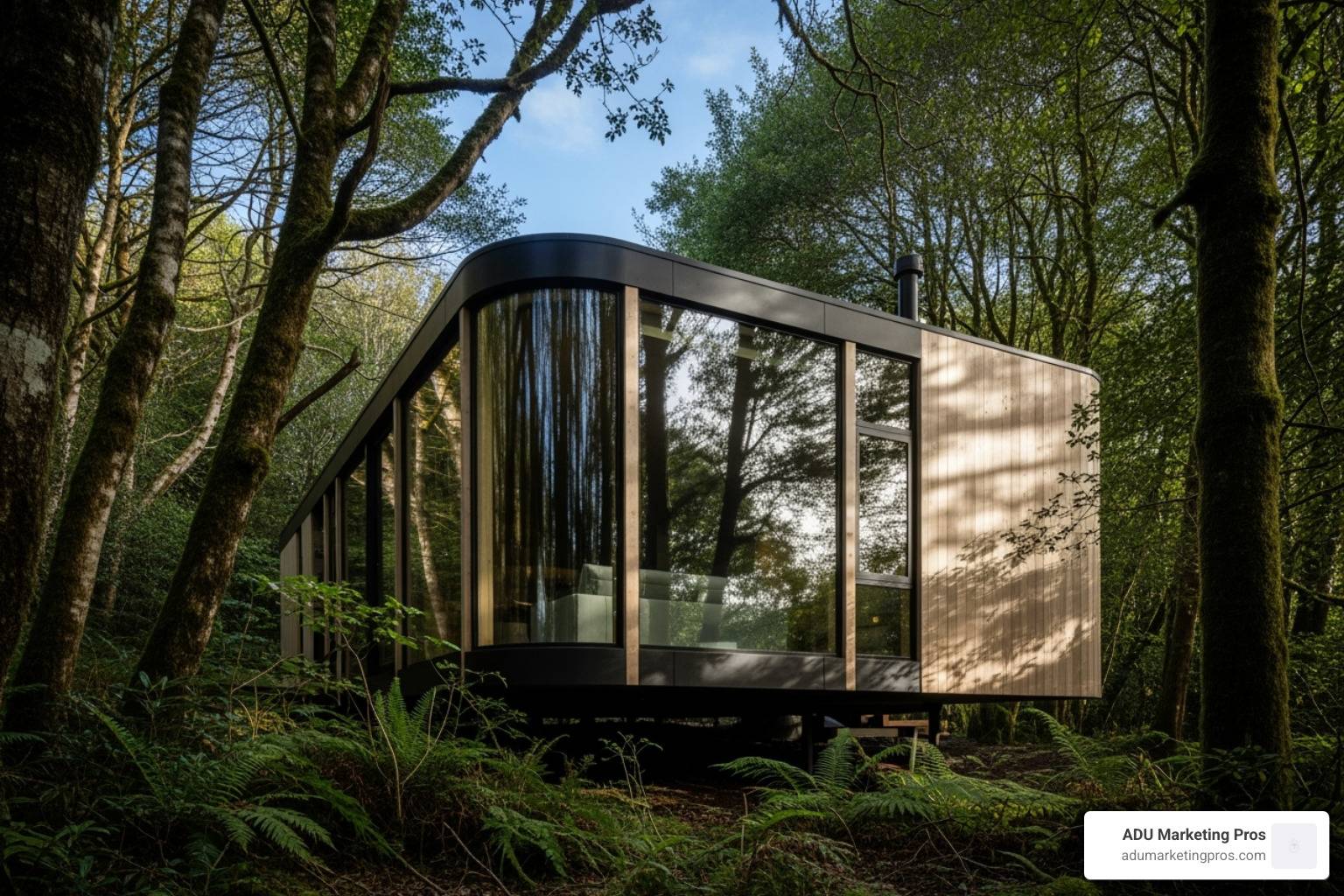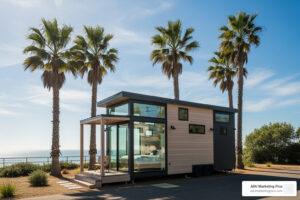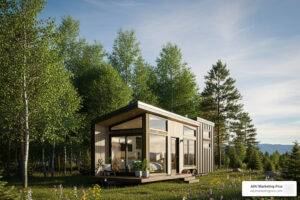Why Pod Houses Are Revolutionizing Modern Living
Pod houses for sale are compact, prefabricated modular structures offering a fast, affordable alternative to traditional construction. If you’re searching for pod houses, here’s what you need to know:
Quick Answers:
- Price Range: $12,000 – $200,000+ depending on size and features
- Sizes Available: From 100 sq ft office pods to 1,500+ sq ft family homes
- Construction Time: 4-12 weeks factory build + days for installation
- Common Uses: ADUs, guest houses, home offices, Airbnb rentals, primary residences
- Where to Buy: Direct from manufacturers, prefab marketplaces, specialized builders
More living per square inch—that’s the promise driving the pod house movement. Also called Apple Cabins or Capsule Homes, these factory-built structures are changing how we think about housing. Unlike traditional construction that takes months, pods arrive on-site nearly complete and can be installed in days.
The appeal is clear. As housing costs climb and zoning laws evolve, pod houses fill multiple needs: a backyard ADU for family, a separate home office, a rental property for passive income, or a primary residence for minimalists.
These structures combine modern aesthetics with practical function. They feature steel frames, insulated panels, and double-glazed windows, creating efficient and healthy living spaces. Their versatility is key, with sizes ranging from 100-square-foot workspaces to 1,000+ square-foot family homes. For homeowners and ADU builders, pods offer faster timelines, predictable costs, and sustainable options.
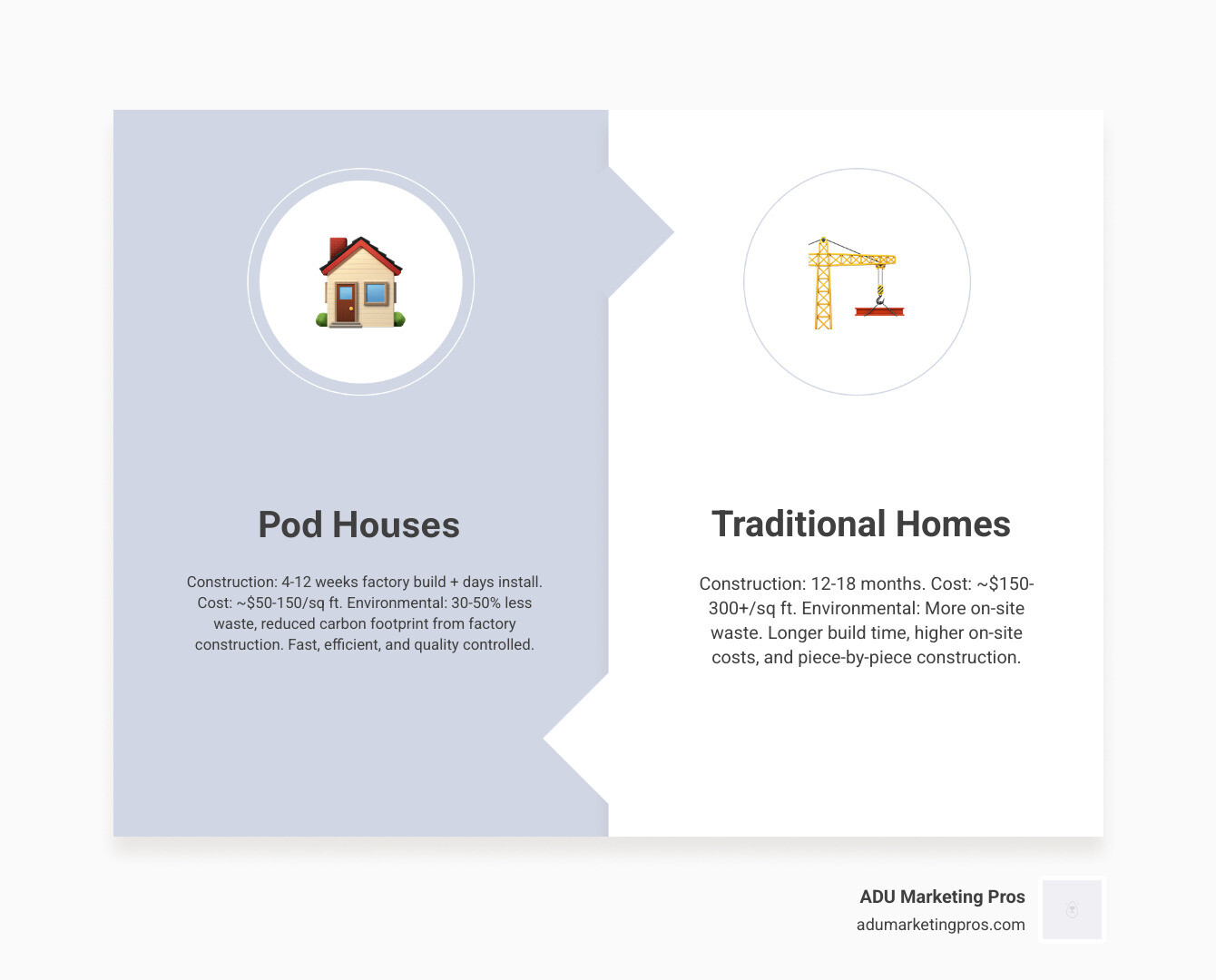
What Exactly Is a Pod House?
Think of pod houses for sale as the smart evolution of prefabricated living. These are thoughtfully designed homes built with factory precision, ensuring consistent quality, minimal waste, and rapid construction timelines. You might hear them called “Apple Cabins,” “Capsule Homes,” or “Modular Cabins”—all names for a philosophy of intentional living without compromising on style.
The modern aesthetics feature clean lines and expansive windows that flood interiors with natural light. Every square inch serves a purpose, with clever built-in storage and multi-functional furniture. The biggest game-changer is the quick installation. While a traditional home takes months to build, a pod house arrives nearly finished and is installed in days. Once the foundation is ready, it’s a matter of crane placement, utility hookups, and final touches.
The Anatomy of a Modern Pod
Quality pod houses are built with materials chosen for long-term performance and energy efficiency.
- Structural Integrity: Robust steel frames provide exceptional strength, resisting fire, termites, and harsh weather. The engineering accounts for wind, seismic activity, and snow loads.
- Insulation: High-quality polyurethane (PU) insulated sandwich wall panels are standard, creating a thermal envelope that keeps interior temperatures stable and utility costs low.
- Windows and Doors: Double-glazed vinyl or aluminum windows are typical, offering natural light and thermal efficiency. Commercial-grade doors add security and performance.
- Interior Finishes: Sustainable materials like wood-plastic composites and EO-grade ecological boards create healthy, beautiful living spaces free from harmful emissions.
Versatile by Design: Common Uses for Pods
The adaptability of pod houses for sale is their greatest strength.
- Primary Residence: Larger designs (800-1,500+ sq ft) function as complete homes for those embracing a minimalist, intentional lifestyle.
- Accessory Dwelling Unit (ADU): In places like San Jose, a backyard pod is a perfect solution for housing aging parents, adult children, or generating rental income.
- Guest House: A pod offers a private retreat for visitors, complete with a bathroom and kitchenette.
- Home Office or Studio: A backyard pod provides a quiet, dedicated workspace, separating professional and personal life without a commute.
- Short-Term Rental: Their unique, modern appeal makes pod houses popular on Airbnb, commanding premium nightly rates.
- Glamping and Resort Accommodation: High-end resorts use luxury pods to offer immersive nature experiences with modern comforts.
Exploring the Different Types of Pod Houses
The world of pod houses for sale is surprisingly diverse, with a style to suit almost any taste, budget, and purpose. From futuristic capsules to cozy cabins, the options go far beyond a single design. Understanding the primary categories can help you narrow your search and find the perfect fit for your property and lifestyle.

-
Expandable Pods: A marvel of engineering, these innovative units arrive in a compact, shipping-container-sized form for easy and affordable transport. Once on-site, they unfold—often with the push of a button using hydraulic systems—to double or even triple their interior footprint in just a few hours. This rapid deployment makes them ideal for homeowners who need flexible space quickly, but also for commercial uses like pop-up retail, event spaces, or even emergency housing solutions. They offer the ultimate in space optimization without a complex, lengthy construction process.
-
Capsule & Space Pods: Defined by their futuristic aesthetic, these pods often feature curved lines, metallic finishes, and massive panoramic windows or skylights that create an immersive connection to the outdoors. They are designed to feel like a high-tech cocoon nestled in nature. While extremely popular as luxury glamping accommodations and unique Airbnb rentals, a growing number of individuals are choosing them as minimalist primary residences that make a bold architectural statement. They prioritize experience and views over sheer square footage.
-
Modular Cabins & “Apple Cabins”: Blending the efficiency of prefabrication with the timeless appeal of rustic design, these structures are perfect for those seeking a modern yet warm retreat. They often feature natural materials like wood cladding, warm interior finishes, and sometimes even traditional gabled rooflines. These cabins integrate seamlessly with natural surroundings, making them a top choice for properties in wooded areas, by a lake, or in the mountains. They offer a sense of coziness and tranquility—a modern take on the classic cabin in the woods.
-
Office Pods & Backyard Studios: These compact units (typically 100-250 sq ft) are purpose-built for productivity and creativity. More than just a shed, a high-quality office pod is a fully finished, insulated, and wired space designed for year-round use. Key features often include soundproofing to minimize household distractions, ample natural light, built-in desks and shelving, and sufficient electrical outlets for all your tech. They provide a crucial separation between professional and personal life, creating a dedicated, commute-free workspace just steps from the main home.
-
Pods on Wheels (THOWs): While technically a type of Tiny Home on Wheels (THOW), these pods share the same design philosophy of compact, efficient living. Built on a trailer chassis, they offer the ultimate freedom to relocate. Unlike a traditional RV, however, these pods are often constructed with higher-quality, residential-grade materials, better insulation, and more sophisticated interior finishes. They provide maximum flexibility for those who value an adventurous or nomadic lifestyle but don’t want to compromise on the comfort and style of a well-designed home.
Each type offers a unique blend of design and functionality. The best choice depends on how you plan to use the space and the aesthetic that speaks to you, making the search for pod houses for sale a personal and exciting journey.
Key Features and Customization Options
When you explore pod houses for sale, you’ll find they are thoughtfully designed spaces that can be customized to your lifestyle and needs. Most pods arrive with the essentials already in place, including functional washrooms, compact kitchenettes, clever built-in storage, and efficient LED lighting. Manufacturers often include small touches like side push-out windows and bedside cupboards that make the space comfortable from day one.
Architectural features like large double-layer windows and skylights are common, changing compact spaces into bright, airy sanctuaries. Many designs also incorporate adjustable spotlights to create the perfect ambiance.
Standard Features vs. Premium Upgrades in Pod Houses
| Feature Category | Standard Offering | Common Premium Upgrades |
|---|---|---|
| Kitchenette/Kitchen | Basic sink, mini-fridge, microwave | Full-size appliances, stone countertops, custom cabinetry, induction cooktop, dishwasher |
| Bathroom | Compact shower, toilet, basic vanity | Spa-like shower, smart toilet, designer fixtures, heated floors, larger vanity |
| Flooring | Durable vinyl or laminate | Hardwood, engineered wood, high-end tile |
| Lighting | Standard LED ceiling lights, switches | Dimmable LED strips, smart lighting systems, integrated spotlights, skylights |
| Storage | Basic built-in shelving, bedside cupboards | Custom closets, integrated storage solutions, hidden compartments |
| Exterior Siding | Standard metal panels, composite materials | Wood siding (cedar, redwood), advanced composite cladding, bespoke architectural finishes |
| Windows/Doors | Double-glazed vinyl windows, standard entry door | Triple-glazed windows, large panoramic sliding doors, smart locks |
| HVAC | Mini-split system (heating and cooling) | Energy recovery ventilators (ERVs), radiant floor heating, smart climate control |
| Technology | Basic electrical outlets, internet ready | Smart home integration (voice control, automated blinds), security systems, EV charging |
| Off-Grid Cap. | Basic utility hookups | Solar panel arrays, battery storage, composting toilets, greywater recycling |
Regarding construction, many pods feature all-steel construction for superior strength and resistance to mold and pests. Reinforced steel roofs are standard in many designs, engineered to handle harsh climates and heavy snowfall. This commitment to durability means you’re investing in a structure built to last.
Customization is where you can truly make a pod your own. Choose from various exterior sidings, interior flooring, and wall treatments. Upgrade appliance packages, integrate smart home technology, or add off-grid capabilities like solar panels and composting toilets. The beauty of pod houses for sale is that they can be custom to your vision and budget, whether you start with a base model or create a fully custom home.
The Financials: Understanding Pod House Costs
One of the biggest draws of pod houses for sale is their affordability compared to traditional construction. However, it’s important to look beyond the initial sticker price to understand the total investment.
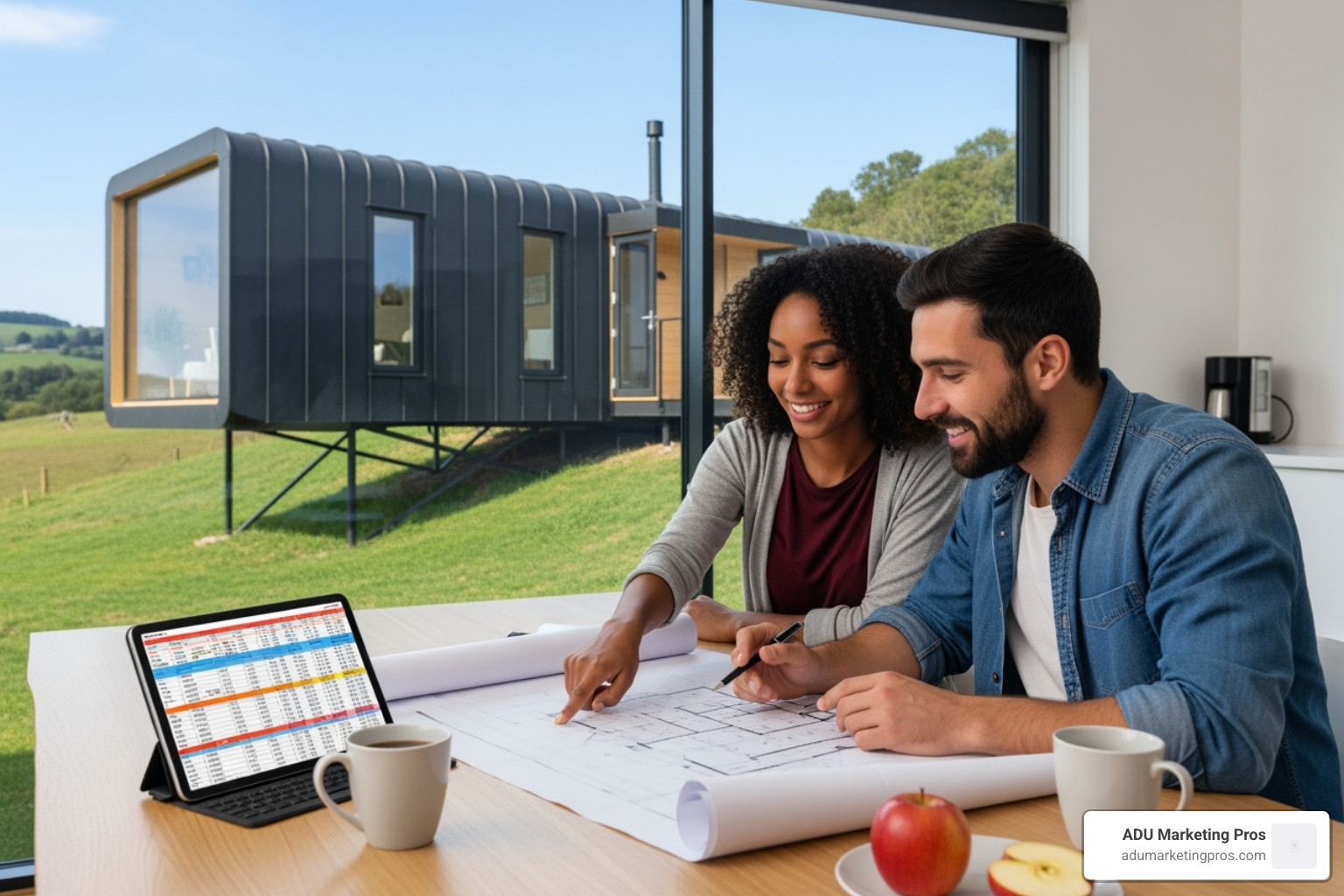
General Price Ranges:
The cost of a pod house can vary significantly based on size, features, and finishes.
- Entry-Level ($12,000 – $40,000): This range typically covers basic office pods or simple shells that may require additional work to become fully functional living spaces.
- Mid-Range ($40,000 – $100,000): Move-in ready studio pods with kitchenettes and bathrooms fall into this category, offering comfortable living space.
- High-End ($100,000 – $200,000+): Larger, multi-bedroom pods designed as primary residences with full amenities can exceed $200,000.
What Drives the Price?
Several factors influence the final cost. Size is the most obvious, but the quality of construction and materials also plays a huge role. Premium insulation, high-end finishes, and customization will increase the price but also add long-term value and comfort. The manufacturer’s reputation and included warranties can also affect the cost.
Additional Costs to Budget For
The pod itself is just one part of the total cost. These “soft costs” can add 20-50% to the total project budget, so it’s crucial to account for them early.
- Land: If you don’t already own property, this will be your largest expense. Land costs vary dramatically by location.
- Site Preparation: Before anything else, your land must be prepared. This involves clearing vegetation, grading the land to ensure it’s level and has proper drainage, and excavation for the foundation and utility lines. A soil report may be needed to determine ground stability.
- Foundation: Your pod needs a stable base. Options include a solid concrete slab, a perimeter foundation, or a pier system (concrete piers or steel screw piles), which is often more cost-effective and less invasive. The choice depends on soil conditions, climate, and pod design.
- Utility Hookups: This is a significant cost. It involves trenching and running lines to connect to municipal water, sewer/septic, and the electrical grid. If you’re in a rural area, you may need to budget for a well and septic system, which can be a major expense.
- Permits and Fees: Navigating bureaucracy has a price. You’ll need to pay for building permits, zoning reviews, and potentially school or park impact fees. These can range from a few thousand to tens of thousands of dollars depending on your municipality.
- Delivery and Installation: The cost to transport the pod from the factory to your site can be substantial, especially for long distances. Installation almost always requires a crane to lift the pod into place, and the cost depends on the size of the crane needed and the complexity of the site access.
Financing Your Pod House
As pod houses gain popularity, financing options are expanding. While traditional mortgages can be tricky for structures not permanently affixed to land in a conventional way, alternatives exist. Personal loans, RV loans (for certified pods on wheels), and home equity loans or HELOCs are common options. Some manufacturers also offer direct financing or partner with lenders familiar with prefabricated homes. For a helpful overview of how lenders approach small and alternative homes, see Investopedia’s guide to financing tiny homes.
With proper planning, pod houses for sale remain an attractive and affordable path to homeownership or property expansion.
Your Guide to Finding and Installing Pod Houses for Sale
Once you’ve decided on a style, the next step is understanding where to find pod houses for sale and how to get one onto your property. The market has expanded, giving buyers more options than ever.

Where to Find Pods:
- Direct from Manufacturers: Going straight to the source, such as companies like Chery Industrial, EcoPods, and Space Haven, is often the best route. This allows for the deepest level of customization, direct communication with the people building your home, and clear warranty support. You get transparent pricing and expert guidance throughout the process.
- Prefab Home Marketplaces: Online platforms like Dwell and PrefabReview aggregate listings from various manufacturers. These sites are excellent for initial research, allowing you to easily compare different styles, floor plans, and price points in one place before you start reaching out to individual companies.
- Local ADU Builders and General Contractors: In markets with high demand for ADUs, like San Jose or Los Angeles, specialized local builders are an invaluable resource. They not only offer prefabricated solutions but also provide turnkey services, managing the entire project from permits to installation. Their expertise in navigating complex local zoning and building codes can save you immense time and stress.
The purchasing process is straightforward, moving from an initial inquiry and design consultation to a contract, factory production (typically 4-12 weeks), and finally, delivery and installation. Modern pod houses are engineered for durability, with many featuring all-steel frames designed to last 50 years or more, often backed by a 10-year builder’s warranty.
Key considerations when looking for pod houses for sale
Before purchasing, address these practical realities:
- Zoning and Land Use: Local laws dictate what you can build, its size, and its placement. ADU regulations in California, for example, have specific rules for setbacks and square footage. The California Department of Housing and Community Development maintains a comprehensive overview here: Accessory Dwelling Units (ADUs).
- Local Building Codes: Your pod must comply with local codes for safety, structural integrity, and energy efficiency. Reputable manufacturers design their pods to meet standard codes (like the International Residential Code or IRC), but always confirm compliance for your specific location. For an industry overview, see the National Association of Home Builders: Building Codes and Standards.
- Site Access: This is a critical logistical hurdle. Can a large delivery truck and crane access your property? Obstacles like narrow streets, low-hanging power lines, or large trees can significantly complicate or even prevent installation. A site visit from the manufacturer or installer is essential.
- Foundation Requirements: Your pod will need a foundation, such as a concrete slab, piers, or screw piles, depending on its design and local soil conditions. This needs to be prepared and approved before the pod is delivered.
- Utility Connections: Plan for water, sewer, and electrical hookups early. The process and cost can vary widely, so consult with local utility companies and contractors to get accurate estimates and avoid delays and budget surprises.
The installation process for pod houses for sale
Once permits are secured, the on-site process is remarkably fast:
- Site Preparation: The area is cleared, graded, and prepared for the foundation.
- Foundation Installation: The chosen foundation is installed and given time to cure if necessary.
- Crane Delivery and Placement: The finished pod arrives on a flatbed truck and is carefully lifted by a crane onto the prepared foundation.
- Securing the Structure: The pod is anchored firmly to the foundation to ensure structural stability.
- Utility Hookup and Final Inspection: Licensed plumbers and electricians connect the water, sewer, and electrical lines. This is followed by a final review from local building inspectors to grant a certificate of occupancy.
The entire on-site process, from pod arrival to final inspection, typically takes just a few days to a week.
Frequently Asked Questions about Pod Houses
As a newer housing solution, pod houses for sale generate many questions. Here are answers to some of the most common inquiries.
Are pod houses energy-efficient?
Yes, energy efficiency is a core benefit of modern pod house design.
- Superior Insulation: High-quality polyurethane (PU) insulated sandwich panels offer excellent thermal resistance, keeping the interior comfortable year-round.
- Airtight Construction: Factory-built precision results in a more airtight structure, minimizing drafts and heat loss compared to many site-built homes.
- Double-Glazed Windows: Standard double-glazed (and often low-E coated) windows significantly reduce heat transfer, lowering energy consumption.
- Lower Utility Costs: The combination of these features translates directly to lower heating and cooling bills and a smaller carbon footprint.
- Solar-Ready: The simple rooflines of many pod designs are ideal for rooftop solar panels, making it possible to achieve low or even net-zero energy consumption.
For general home energy efficiency best practices, the U.S. Department of Energy’s Energy Saver portal is a helpful resource: Energy Saver.
How long does it take to build and install a pod house?
The timeline is a major advantage over traditional construction.
- Factory Construction: Manufacturing in a controlled environment typically takes 4 to 12 weeks. This process is immune to the weather delays that plague on-site construction.
- On-Site Installation: Once delivered, installation is incredibly fast. The pod is often craned into place and secured in a single day. Utility hookups and final touches take a few more days.
- Total Timeline: From order to move-in, a pod house can be ready in as little as 2-4 months, a fraction of the 12-18+ months common for a stick-built home. This offers incredible predictability and speed.
Can pod houses withstand harsh weather?
Yes, they are engineered for durability and resilience in various climates.
- Climate-Specific Engineering: Reputable manufacturers design pods to handle specific local conditions, from the heavy snow loads of mountain regions to the high winds of coastal areas.
- Reinforced Steel Frames: Robust steel architecture provides superior strength and a high strength-to-weight ratio, offering excellent resistance to wind and seismic forces.
- Heavy Snow Load Capacity: Roofs are often reinforced and engineered to handle heavy, prolonged snow accumulation in colder regions, a key factor to verify with your manufacturer.
- Fire and Termite Resistance: Steel-based construction offers inherent resistance to fire and pests like termites, providing extra safety and peace of mind.
What kind of maintenance do pod houses require?
Pod houses are generally considered low-maintenance, thanks to the modern, durable materials used in their construction. However, like any home, they require some upkeep.
- Exterior: The metal or composite siding is highly durable and may only need occasional cleaning. It’s wise to periodically inspect the seals around windows and doors to ensure they remain watertight. The roof should also be checked for debris or any signs of wear, though steel roofs are designed to last for decades.
- Interior: Inside, maintenance is the same as any modern home: cleaning, caring for floors and surfaces, and checking for any leaks under sinks.
- Systems: The HVAC mini-split system will require periodic filter cleaning or replacement to run efficiently. It’s also good practice to check plumbing and electrical systems annually.
Overall, because pods are built with new, high-performance materials and are protected from the elements during construction, they often require less immediate and long-term maintenance than older, traditionally built homes.
Conclusion
We’ve journeyed through pod houses for sale, and the takeaway is clear: these compact, thoughtfully designed structures are a practical, forward-thinking response to modern housing needs. They offer affordability, sustainability, speed, and incredible flexibility. A pod can be a primary residence, a welcoming ADU, a productive home office, or a profitable rental property.
For those in the ADU and modular home market, especially here in California, it’s an exciting time. The options are expanding, and more homeowners are finding that prefabricated structures can meet their needs without the long wait or high cost of traditional construction.
At ADU Marketing Pros, we are passionate about this evolution. Based in San Jose, CA, we live and breathe the ADU sector. We understand the challenges ADU builders and architects face in this competitive market—from standing out to communicating value beyond price.
If you’re a builder or architect specializing in ADUs, pod houses, or modern prefab solutions, we’re here to help you connect with homeowners ready to accept this future. Our marketing solutions focus on your expertise over price and are custom to the ADU niche: targeted SEO that wins local intent, high-ROI PPC campaigns, conversion-focused landing pages, content and social strategies that build authority, and analytics that prove ROI. We combine continuous market research, data-driven insights, and an agile testing approach to keep you ahead of shifting regulations and consumer behavior across Los Angeles, San Diego, the San Francisco Bay Area, San Jose, Sunnyvale, Palo Alto, Mountain View, and Menlo Park.
We believe in the power of specialized knowledge. That’s why we focus exclusively on the ADU industry—because generic marketing isn’t enough when you’re offering something this innovative.
Find out how to market your modern prefab granny flats and let’s work together to build a more flexible and sustainable future, one pod house at a time.

